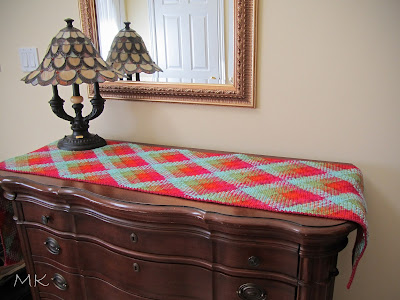Z tej okazji prezentuje Wrzesniowy Bieznik. Nazwalam go tak, poniewaz bedzie sobie lezal na stole, lub gdziekolwiek, od wrzesnia, az do poczatku grudnia. I choc zaczelam go jeszcze w tamtym roku, to jak przystalo na wszystko co sie zalapalo na rok 2020, okazal sie on malym koszmarkiem w robocie. A bylo to tak...(*Od razu przepraszam za dlugi post, ale musze to z siebie wyrzucic. Do dzis mam przez to cos w sensie lekkiego stresu pourazowego. Tak, definitywnie przesadzam. 😄 )
Postanowilam wydziergac bieznik metoda Planned Pooling (oficjalna nazwa darmowego wzoru: Red Heart Planned Pooling Argyle Table Runner, ktory znajdziecie tutaj). Metoda ta jest latwa, szybka i przyjemna, pod warunkiem, ze sie dobierze odpowiednia wloczke, czyli taka, w ktorej odcinki i kolejnosc indywidualnych kolorow sa jednakowe poprzez caly motek, oraz w kazdym nastepnym motku. Aby uproscic ludziom robote, firmy zaczely produkowac wloczki specjalnie do tej metody. Owszem, moga byc malutkie roznice w dlugosci kolorow, bo to latwo naprawic roznicowaniem napiecia wloczki i wielkoscia oczek. Jesli sie nie myle, wzor bieznika zostal napisany zanim zaczeli produkowac specjalne wloczki, wiec aby nie poniesc porazki, zakupilam dokladnie taka sama wloczke (tzn. firma, rodzaj i kolor), jakiej uzyto w oryginale. Na poczatku szlo fajnie, ale gdzies tak w polowie pierwszego motka zauwazylam male odcinki nowych (tzn. nieplanowanych) kolorow. Zauwazylam tez, ze niektore kolory roznia sie miedzy sekwencjami, n.p. jedna miala ciemny braz, w nastepnej ten braz zamienial sie w jasny bez, a potem w pomaranczowo-rudy. Z tym jeszcze dalam rade, ale odcinki kolorow zaczely zmieniac dlugosc. I to bardzo znacznie, n.p. jesli odcinek niebieskiego mial w jednej sekwencji 30 cm starczajacej na 5 oczek, to juz w drugiej mogl miec az 60 cm! I co zrobic z tak duzym nadmiarem koloru? Otoz mozna zrobic oczko grubsze/podwojne. Z tym, ze wtedy te oczka nie wygladaja juz tak dobrze, bo sa grubsze i bardziej wyraziste. Gorzej jesli odcinek koloru jest za krotki na planowana ilosc oczek, bo to tez sie zdarzalo dosyc czesto. I zeby chociaz jeden kolor tak sie roznil dlugoscia, ale nie - dotknelo to wszystkich. Aby koszmarek byl bardziej urozmaicony, jeden z motkow mial sekwencje kolorow w zlej kolejnosci (a tego juz nie da sie naprawic w zaden sposob), chociaz zaczelam wloczke od srodka motka, tak, jak wszystkie inne. Na szczescie, sekwencja kolorow zostala zachowana kiedy zaczelam motek od drugiego konca. Wszystko to oznaczalo ze, a) bylo duzo czestego prucia, aby zmiescic i dostosowac ilosc koloru do ilosci oczek, b) zajelo to trzy razy dluzej, niz powinno, c) bylo duzo frustracji. Niewykluczone, iz ktos inny by to wszystko rzucil w kat, ale ja jestem do polowy uparta, choc moja niecierpliwa polowa jednak zrezygnowala z dziergania ozdobnego obramowania. No dobra, wiecej nie truje i slicznie dziekuje za cierpliwosc. Efekt koncowy jest jednak dostateczny i definitywnie da sie z tym zyc.😀 Wiecej fotek ponizej.
Pieknie dziekuje za odwiedziny i zycze Wam spokojnego i cieplego dnia.
Hello, there! Today, I present my September Table Runner. I'm calling it that way, because it'll be on my table (or some other furniture) from September to December. Even though I started it back in 2019, in true 2020 fashion, it came to be a small nightmare by the time this year rolled around. It went like this... (*I apologize for the long post, but I have to get this off my chest. To this day, I have some form of mild stress response from this - yes, I am definitely exaggerating. 😄). I decided to make the Red Heart Planned Pooling Argyle Table Runner (you can find the free pattern here). Planned Pooling is a quick, easy and fun method, provided you choose the right yarn, since its color lengths and sequences should be nearly identical throughout each skein. To make this easier, some companies began producing yarn especially designed to be used with this method. I believe that the pattern I chose was written prior to such yarns being on the market, so to avoid a fiasco I bought the same yarn, in the same colorway used in the original pattern instructions. At the beginning, everything was fine, but somewhere in the middle of the first skein, I noticed small sections of new (i.e. unplanned) colours. I also noticed that some colours differed between sequences, i.e. one section would have dark brown, the next one would have light beige, yet next one still would have orange-brown. I could still work with that, but the individual colour sections started to vary in length, eg. blue in one sequence would be 12" long, making about 5 single crochet stitches, but the next one, would be 24" long!!! What to do with so much excess of one colour? Well, I could, and did, make double stitches, but that makes them much thicker and bumpier. It's harder still, when a color section is suddenly much shorter, and thus insufficient, to make a planned amount of stitches! If it was only one colour that did that, but no... it was all of them! To make everything even more "interesting", one of the skeins had colours in the wrong sequence and that generally can not be fixed (I started all skeins from the middle). Luckily, the sequence "returned" when I started that one skein from the other end. So, all that meant that a. there was LOTS of FREQUENT frogging in order to fit the amount of yarn into the amount of stitches per colour, b. it took three times as long, as it should have, c. there was a lot of frustration. Perhaps someone else would have abandoned it, but I'm half stubborn - the impatient half of me decided not to make the decorative edging. Ok, I think it's time to stop with my whining now. 😀 Thank you so much for your patience. In the end, the table runner looks acceptable and I can definitely live with it. 😀
Thank you so much for visiting. Wishing you a lovely and warm day.












.jpeg)












.png)










